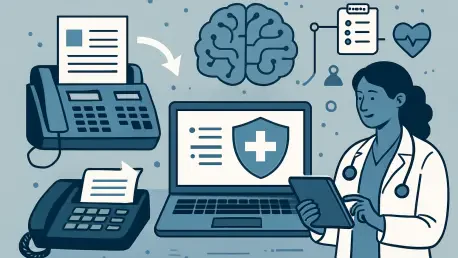In an era where digital innovation drives most industries forward, the healthcare sector often finds itself tethered to outdated technologies like fax machines, largely due to stringent privacy regulations and interoperability barriers. At the University of Pennsylvania Health System (UPHS), part of Penn Medicine, a remarkable solution has emerged to address this persistent challenge. An AI-powered tool known as Coordn8, developed by the Penn Medicine Center for Health Care Transformation and Innovation (CHTI), is revolutionizing the way faxes are processed and new patients are onboarded. Highlighted in a recent publication in NEJM Catalyst, this system confronts long-standing administrative inefficiencies with cutting-edge automation. By transforming a cumbersome, manual process into a streamlined operation, Coordn8 not only saves time but also enhances the focus on patient care, proving that even legacy systems can be modernized with the right technological intervention.
Boosting Efficiency with Cutting-Edge Automation
The sheer volume of faxes handled daily at UPHS—thousands of documents requiring integration into electronic health records (EHRs)—once posed a significant burden on staff, with each fax taking an average of two minutes to process. With the introduction of Coordn8, that time has been dramatically reduced to just 40 seconds per document. For every 100,000 faxes—a threshold UPHS reaches approximately every 11 to 12 days—this translates to over 2,300 hours saved. Such efficiency gains are more than mere numbers; they represent a fundamental shift in how administrative tasks are managed, allowing staff to redirect their efforts toward more critical, patient-centered activities. The automation of these repetitive processes underscores the potential of AI to overhaul even the most entrenched operational bottlenecks in healthcare settings, setting a new standard for administrative productivity.
This leap in efficiency extends beyond time savings to impact the broader workflow at UPHS. Before Coordn8, the manual handling of faxes often led to delays and errors, creating frustration among administrative teams and slowing down patient care coordination. Now, with the AI-driven system in place, the accuracy and speed of document processing have improved significantly, minimizing the risk of misplaced or delayed information. This transformation ensures that vital patient data is integrated into EHRs promptly, facilitating quicker decision-making by clinical staff. Furthermore, the reduction in manual workload has alleviated stress on employees, enabling them to engage more effectively in their roles without the constant pressure of paperwork. The ripple effect of this operational upgrade demonstrates how targeted technological solutions can create a more seamless and responsive healthcare environment.
Elevating Staff Morale Through Workflow Improvements
One of the most notable impacts of Coordn8 at UPHS is the marked improvement in staff satisfaction. During a nine-month pilot conducted a few years ago, satisfaction with the fax intake process surged from 35% to 60% within just two weeks of implementing the system. A parallel metric, the effort score, which measures the perceived difficulty of filing faxes, showed an identical improvement, reflecting a substantial reduction in workload strain. By automating tedious administrative tasks, Coordn8 has empowered clinical and administrative teams to focus on direct patient interactions rather than being bogged down by paperwork. This shift not only enhances job fulfillment but also strengthens the overall quality of service delivery, highlighting the human benefits of integrating AI into healthcare operations.
The positive changes in staff morale have broader implications for retention and productivity at UPHS. Administrative burdens often contribute to burnout among healthcare workers, a challenge that many institutions struggle to address. With Coordn8 alleviating much of this pressure, employees report a renewed sense of purpose in their roles, as their time is spent on meaningful tasks rather than repetitive data entry. This improvement in workplace atmosphere fosters a culture of innovation and adaptability, encouraging staff to embrace further technological advancements. Additionally, the system’s design ensures continuity during staff absences, preventing workflow disruptions and maintaining consistent service levels. Such resilience in operations underscores how AI tools can support not just efficiency but also the well-being of those on the front lines of healthcare delivery.
Accelerating Patient Onboarding with Digital Solutions
A standout feature of Coordn8 lies in its ability to streamline the patient consent process through a digital innovation called eDisclosure. Historically, obtaining signed release-of-information forms via mail at UPHS took an average of one week, creating delays in accessing critical patient records. By utilizing Penn Medicine’s Way to Health platform to send these forms via text message, Coordn8 has reduced that waiting period by 85%, shaving off six days from the process. Staff satisfaction with this aspect of onboarding skyrocketed from 41% to 90%, showcasing the system’s effectiveness. Importantly, patients retain the option to use paper forms if preferred, ensuring accessibility while embracing digital efficiency. This balance of speed and flexibility marks a significant advancement in how healthcare systems manage patient intake.
Beyond the immediate time savings, the digitization of consent forms through Coordn8 has far-reaching benefits for patient care coordination. Faster access to health records means that medical teams can make informed decisions sooner, reducing delays in treatment planning and improving outcomes. This acceleration is particularly vital for new patients who often require prompt integration into the system to address urgent health needs. The overwhelmingly positive feedback from staff further indicates that the tool not only meets operational goals but also aligns with user expectations for ease and reliability. By addressing a critical pain point in the onboarding process, Coordn8 sets a precedent for how digital tools can enhance both administrative efficiency and the patient experience, paving the way for broader adoption of similar innovations across healthcare settings.
Expanding Impact and Scalability Across Institutions
The strategic implementation of Coordn8 began with over 150 fax lines across various UPHS departments and is now extending to outpatient services throughout Penn Medicine. Yevgeniy Gitelman, MD, head of Custom Software at CHTI, emphasizes the importance of targeting departments with the highest need and readiness for adoption to maximize impact and build momentum. Processing over 3,000 faxes daily and saving 8,500 staff hours in a span of just over 18 months, Coordn8 presents a replicable model for other health systems, regardless of their scale. This scalability suggests that the benefits of AI-driven automation can address universal administrative challenges, offering a blueprint for institutions seeking to modernize outdated processes while adhering to regulatory constraints.
Looking ahead, the potential for Coordn8 to influence healthcare beyond Penn Medicine hinges on tailored implementation strategies that account for diverse organizational contexts. The success at UPHS demonstrates that starting with high-impact areas can create visible wins, fostering broader acceptance of technological change. For other systems considering similar solutions, the focus should be on aligning innovations with specific workflow pain points and cultural readiness. As the tool continues to expand, ongoing evaluation of its performance will be crucial to refine its application and ensure sustained benefits. The journey of Coordn8 reflects a growing recognition within the industry that AI can tackle even the most stubborn inefficiencies, providing a pathway to balance operational demands with a renewed emphasis on patient-centered care.









